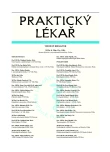Deliberate self-harm – a serious symptom and dangerous social phenomenon
Authors:
E. Malá
Authors‘ workplace:
Vedoucí lékař: prim. MUDr. Martin Jarolímek
; Denní psychoterapeutické sanatorium Ondřejov, Praha
; Neurologická klinika 1. LF UK a VFN
; Přednosta: prof. MUDr. Evžen Růžička, DrSc.
; Univerzita Karlova v Praze
Published in:
Prakt. Lék. 2009; 89(9): 494-498
Category:
Of different specialties
Overview
Deliberate self-harm syndrome (DSH, or SIB, self injurious behaviour), is a dangerous and serious problem. Apart from rare cases of psychotic motivation, the factors triggering DSH are unclear. An estimated 4 % of adults in the general population self-harm. The typical age of onset for DSH is adolescence. Up to 75 per cent of DSH sufferers report feeling no pain during the DSH act. This is generally explained by the involvement of the endogenous opioid system or dissociative mechanisms. The most worrisome and yet neglected aspect of DSH is the high suicide risk it entails. This is confirmed again and again by the day-to-day follow-up of DSH patients.
Key words:
deliberate self-harm, endogenous opioid system, suicide, emo.
Sources
1. Malá, E. Sebepoškozování. ZN - Lékařské listy, 2009, 7 , s. 5-10.
2. Roy, A. Self-destructive behavior. The psychiatric clinics of North America. Philadelphia: W.B.Saunders comp., 1985.
3. Malá, E. Dítě a stres. Praha: Tigis, 2007.
4. Platznerová, A. Sebepoškozování. Praha: Galén, 2009.
5. Babáková, L. Sebepoškozování v dětství a adolescenci. Psychiatrie pro praxi 2003, 4, s. 165–169.
6. Krieglová, M. Záměrné sebepoškozování v dětství a adolescenci. Praha: Grada, 2008.
7. Grossman, R., Siever, L. Impulsive self-injurious behaviors: neurobiology and psychofarmacology. In: Simeon D, Hollander E. (Eds.). Self-Injurious Behaviors. Assessment and Treatment. Arlington: American Psychiatric Publishing Inc., 2001, p. 117-147.
8. Simeon, D., Hollander, E. (Eds.) Self-Injurious Behaviors. Assessment and Treatment. Arlington: American Psychiatric Publishing Inc., 2001. ISBN 9780880488082.
9. Mendoza, Y., Pellicer, F. Pain perception in self-injurious syndrome. Salud. Ment. 2002, 25(4), p.10-16.
10. Saxe, G.N., Chawla, N., Van-der-Kolk, B. Self-destructive behavior in patients with dissociative disorders. Suicide Life Threat. Behav., 2002, 32(3), p. 313-20.
11. Ayton, A.K., Rasool, H., Cottrell, D. Deliberate self-harm in children and adolescents: Association with social deprivation. Eur. Child Adolesc. Psychiat., 2003, 12(6), p. 303-307.
12. Beckett, C., Bredenkamp, D., Castle, J. et al. Behavior patterns associated with institutional deprivation: a study of children adopted from Romania. J. Dev. Behav. Pediatr., 2002, 2(5), p. 297-303.
13. Hawton, K., Haw, C., Townsend, E. Family history of suicidal behaviour: prevalence and significance in deliberate self-harm patients. Acta Psychiatr. Scand., 2002, 106(5), p. 387-393.
14. Hawton, K., Zahl, D., Weatherall, R. Suicide following deliberate self-harm: long-term follow-up of patients who presented to a general hospital. Br. J. Psychiat. 2003, 182, p. 537-542.
15. Zahl, D., Hawton, K. Repetition of deliberate self-harm and subsequent suicide risk: long-term follow-up study of 11,583 patients. Br. J. Psychiat. 2004, 185, p. 70-75.
16. Nicholson, C. The ‘rights’ of passage. Gender-specific initiation rites in the understanding of self-harm. Ther. Communities: Int. J. Ther. Supportive Organ., 2004, 25(1), p. 17-30.
17. Malá, E. Sebepoškozování u PPP. In: Raboch, J. a kol.. Nemocná duše - nemocný mozek. Praha: Galen, 2006.
18. Herpertz, S.C., Zanarini, M., Schulz, CS. et al. World Federation of Societies of Biological Psychiatry (WFSBP) guidelines for biological treatment of personality disorders. World J. Biolog. Psychiat. 2007, 8(4), p. 212-244.
19. Moran, M. Psychoterapy for BPD gets growing evidence base. Psychiat. News 2007, 42(2), p. 26.
20. Kocourková, J., Koutek, J. Sebepoškozování u pacientů s PPP. Čes. a slov. Psychiat. 2003, 99; Suppl 1, s. 25.
21. Burns, J., Dudley, M., Hazell, P., Patton, G. Clinical management of deliberate self-harm in young people: the need for evidence-based approaches to reduce repetition. Aust. NZ. J. Psychiat. 2005, 39(3), p. 121-128.
22. Einfeld, S., Tobin, M., Beard, J. et al. Sustaining evidence-based practice for young people who self-harm: a 4-year follow-up. Austr. Health Rev. 2004, 27(2), p. 94-99.
Labels
General practitioner for children and adolescents General practitioner for adultsArticle was published in
General Practitioner

2009 Issue 9
Most read in this issue
- Depression and anxiety in pregnant women
- Deliberate self-harm – a serious symptom and dangerous social phenomenon
- Dementia in a general practitioner‘s office
- Echocardiography and anticoagulation treatment of patients with cardioembolic stroke
